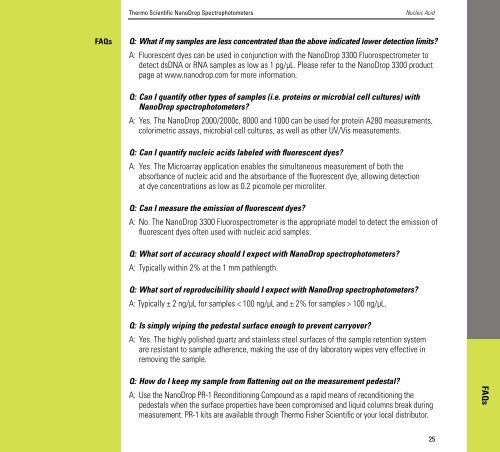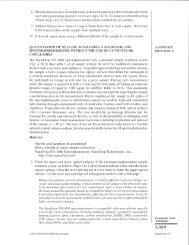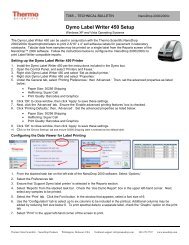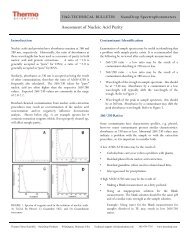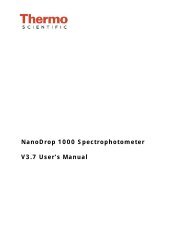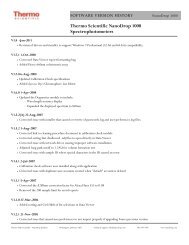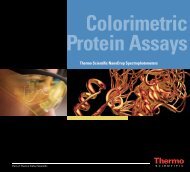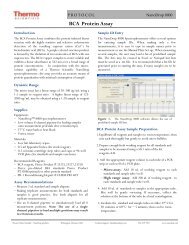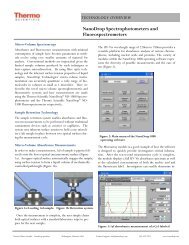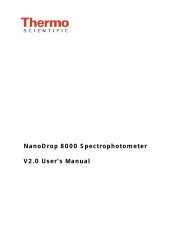Download this publication as PDF - NanoDrop
Download this publication as PDF - NanoDrop
Download this publication as PDF - NanoDrop
Create successful ePaper yourself
Turn your PDF publications into a flip-book with our unique Google optimized e-Paper software.
Thermo Scientific <strong>NanoDrop</strong> SpectrophotometersNucleic AcidFAQsQ: What if my samples are less concentrated than the above indicated lower detection limits?A: Fluorescent dyes can be used in conjunction with the <strong>NanoDrop</strong> 3300 Fluorospectrometer todetect dsDNA or RNA samples <strong>as</strong> low <strong>as</strong> 1 pg/μL. Ple<strong>as</strong>e refer to the <strong>NanoDrop</strong> 3300 productpage at www.nanodrop.com for more information.Q: Can I quantify other types of samples (i.e. proteins or microbial cell cultures) with<strong>NanoDrop</strong> spectrophotometers?A: Yes. The <strong>NanoDrop</strong> 2000/2000c, 8000 and 1000 can be used for protein A280 me<strong>as</strong>urements,colorimetric <strong>as</strong>says, microbial cell cultures, <strong>as</strong> well <strong>as</strong> other UV/Vis me<strong>as</strong>urements.Q: Can I quantify nucleic acids labeled with fluorescent dyes?A: Yes. The Microarray application enables the simultaneous me<strong>as</strong>urement of both theabsorbance of nucleic acid and the absorbance of the fluorescent dye, allowing detectionat dye concentrations <strong>as</strong> low <strong>as</strong> 0.2 picomole per microliter.Q: Can I me<strong>as</strong>ure the emission of fluorescent dyes?A: No. The <strong>NanoDrop</strong> 3300 Fluorospectrometer is the appropriate model to detect the emission offluorescent dyes often used with nucleic acid samples.Q: What sort of accuracy should I expect with <strong>NanoDrop</strong> spectrophotometers?A: Typically within 2% at the 1 mm pathlength.Q: What sort of reproducibility should I expect with <strong>NanoDrop</strong> spectrophotometers?A: Typically ± 2 ng/μL for samples < 100 ng/µL and ± 2% for samples > 100 ng/μL.Q: Is simply wiping the pedestal surface enough to prevent carryover?A: Yes. The highly polished quartz and stainless steel surfaces of the sample retention systemare resistant to sample adherence, making the use of dry laboratory wipes very effective inremoving the sample.Q: How do I keep my sample from flattening out on the me<strong>as</strong>urement pedestal?A: Use the <strong>NanoDrop</strong> PR-1 Reconditioning Compound <strong>as</strong> a rapid means of reconditioning thepedestals when the surface properties have been compromised and liquid columns break duringme<strong>as</strong>urement. PR-1 kits are available through Thermo Fisher Scientific or your local distributor.FAQs25


